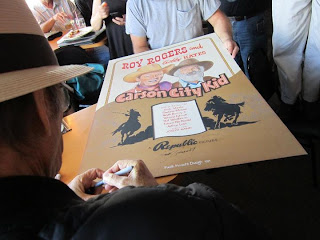 |
| Quintessential Keith courtesy of Roberta deBoer |
He knew it was coming. In fact, he had a little something to say in the matter. He chose to stop the procedure that was keeping him alive, because the quality of life it offered just didn't measure up to his standards. That was Keith.
And knowing his own death was imminent, he did what anyone would have done... he threw a party! Scores of his friends from across the country came to Toledo to swap stories and memories and to catch up with old friends not seen - in some cases - for decades. That was Keith.
Those who knew him thank him for friendship, his talent, and his spirit. Perhaps you knew of him. He was that kind of guy. I hope you'll share your Keith stories here.
Below is his obituary, which pretty much sums it up. Rest in peace, old friend.
 |
| Keith signing the fantasy show card he had previously donated to the museum. His brother plans to donate several more, for which we are very grateful. Photo courtesy of Bob Behounek |
A race that can’t stay still…”
These
words by Robert W. Service begin one of the favorite poems of Keith Knecht, of Toledo, who died August
30, 2011.
The
last stanza of the poem begins, “He has failed, he has failed…,” but no such
charge could be made against Keith, whose life was successful precisely because
he couldn’t and wouldn’t fit in.
Renowned for his work, he won myriad
awards and was frequently interviewed by trade magazines, even appearing in
cover stories. Years of honors crystallized in 2009, when he became the eighth
person in North
America chosen by his peers for a Lifetime Achievement Award.
America chosen by his peers for a Lifetime Achievement Award.
Receiving this honor in Detroit’s Cobo Hall from the Letterheads (a
national brotherhood of sign painters), Keith said: “I got this award for
having too much fun.”
Untethered by marriage or family
obligations, his art and livelihood allowed him to live much of his life on the
road, brush in hand.
His work was found in Canada, California,
Colorado, Florida
(and all along the highways leading there), as well as Las Vegas and the East Coast.
Keith stopped painting when he began to
lose his vision five years ago, shortly after computers dominated sign painting.
Both developments broke Keith’s heart. Of the sorry state of modern sign
painting, he said:
“There’s no romance in it anymore. When I
had a brush in my hand, man, I was at peace. The brush wasn’t an extension of
my hand, it was my hand. Try getting that out of a computer or some vinyl
sticker.”
Keith’s death, like his life, occurred on
his terms. Health declining, in late August he ended thrice-weekly dialysis.
Two days after his last treatment, he had the pleasure of hosting a party, gathering
friends from across the country.
This renaissance man – lover of political
debate, history, jazz, doo-wop, stylish hats, old movies, Packards, a game of
pool well-played, and all things Art Deco – made his mark and will be missed.
He is survived by his hero and brother,
Bruce Knecht, also of Toledo.
As Keith wished, there was a party August
26 in place of funeral services, and he thanks his friends for coming. If you’d
like to memorialize Keith, please consider a donation to the American Sign
Museum, in Cincinnati, or Hospice of Northwest Ohio.



